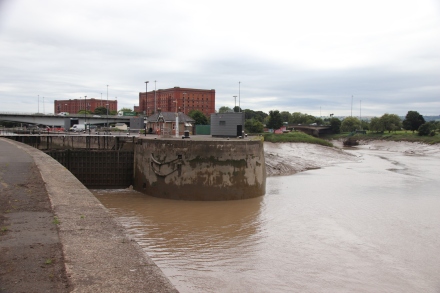Bristol, as a port for the export of woolen cloth and the import of Bordeaux wine, dates back about 1,000 years. It grew up six miles or so up the estuary of the River Avon from where it meets the River Severn and from there – the rest of the world. It developed at the most downstream point of the river where it could still be easily crossed and where ocean-going vessels could be carried upstream to the centre of town on the tidal current in the river. Ships would sail up the Bristol Channel and the Severn before turning up the Avon.
The tidal range of the rivers around here is the second largest in the world. Even in the centre of Bristol the tide can rise and fall as much as 12 metres and this occurs twice a day.
The advantage of carrying vessels on the tide into the centre of town was offset by the fact that as the tide goes out, they can be left floundering helplessly in the mud in harbour or marooned on the river.
By 1760 these problems intensified for the larger ships of the day. On each tide the river became very crowded with so many ships trying to reach or leave Bristol. On the monthly neap tides the river lacked adequate water and vesels were unable to move, stuck in port or at the mouth of the Avon for two weeks or so. At low tide all the large ships went aground, crowded together, with the real danger of fire spreading uncontrollably throughout the harbour.
Vessels started to go elsewhere and the town was losing trade. Merchants came up with the idea of damming the river and making the harbour non-tidal. The tidal river was diverted (here, to the right) and a huge lock constructed at the entrance to the harbour.
Boats could now enter and remain floating at all times. The Floating Harbour opened in 1809 and Bristol became a hugely flourishing trading centre until it closed to commercial traffic in 1975. The Victorian manufacturing heritage can clearly be seen, including the old tobacco factory.
Throughout the 20th century Avonmouth took over the role of the major port in the area. Commercial shipping was built larger and larger and a new breed of cruise-liners emerged which could no longer negotiate the meanders of the river.
Indeed, when the SS Great Britain, the iron-built luxury ocean liner that changed history, was launched in 1863, not only did it become stuck on the river on its journey out of port, but the lock walls had to be dismantled to get it through.
The idea of a bridge over the Avon Gorge was first muted in 1753. Brunel came up with plans. These were revised and eventually built after his death. This temple to Victorian engineering opened in 1864.
The large docks in Avonmouth were opened in 1903 and handles copious amounts of raw materials, manufactured exports including motor vehicles and a growing amount of cruise traffic.











You must be logged in to post a comment.